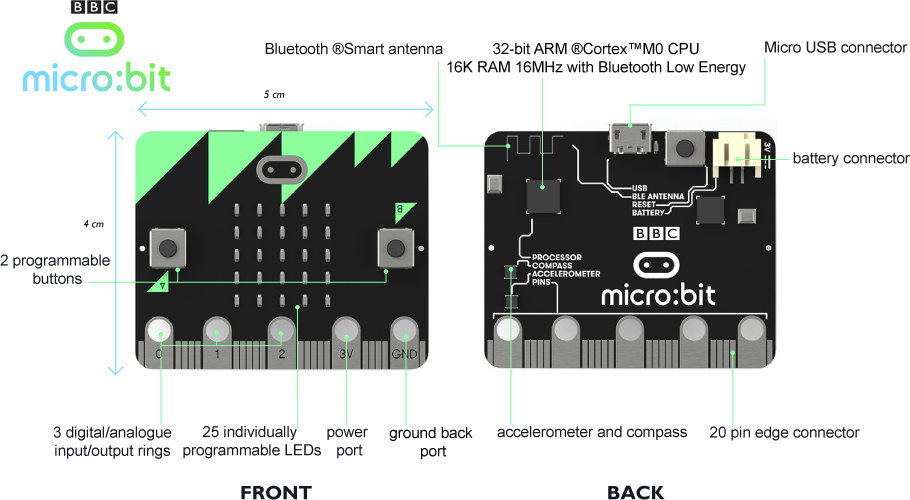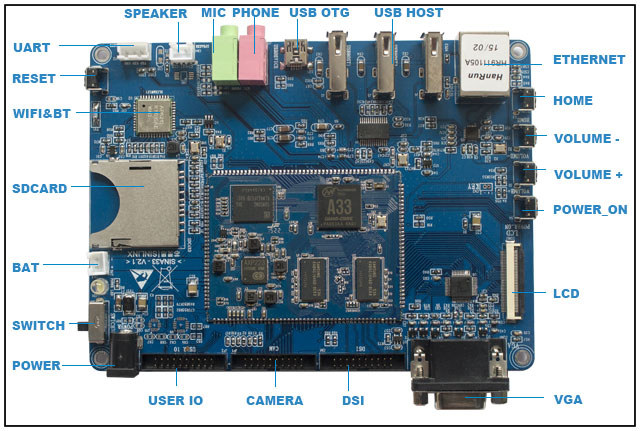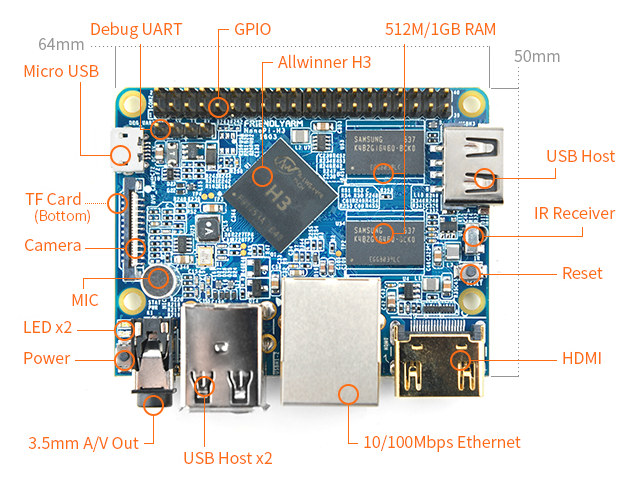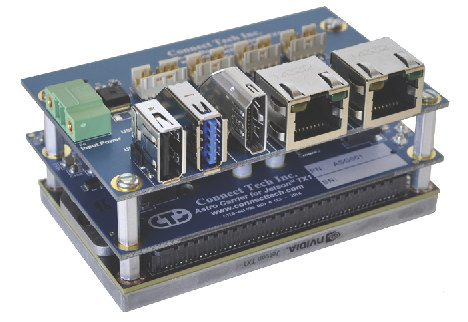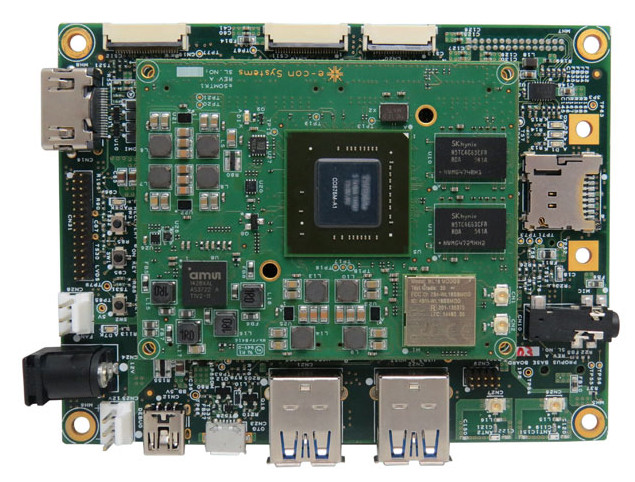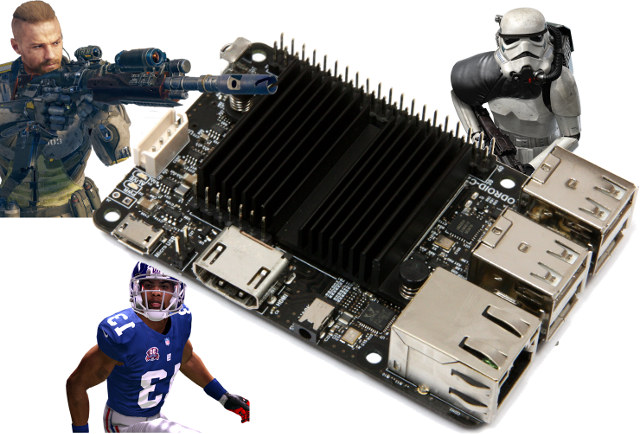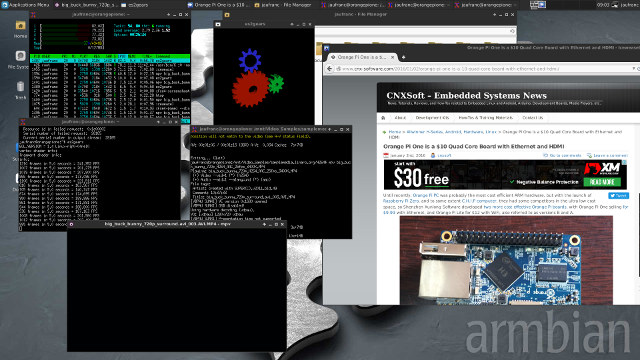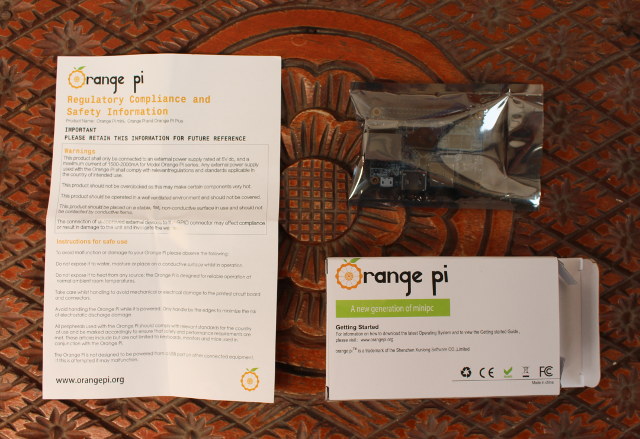After several delays, BBC is now giving free Micro:Bit Bluetooth LE enabled boards to UK students with the goal of getting them interested in coding and electronics in a way that’s even easier and cheaper than using a Raspberry Pi board. Micro:bit specifications: MCU – Nordic nRF51822 Bluetooth SoC based on Cortex M0 core @ 16MHz with 16KB RAM 2x user buttons, 1x reset button 25x red user LEDs in a 5×5 matrix Connectivity – Bluetooth LE Sensors – Compass, magnetometer, accelerometer USB – 1x micro USB port for port and programming Expansion – 20-pin edge connector, 5x “rings” for 3V, GND, and 3 digital/analog I/Os Power – 5V via USB or battery port to connect two AAA batteries Dimensions – 4cm x 5cm There are four ways to “code” the board: Code Kingdoms JavaScript graphical ‘drag and drop’ and text-based programming, Microsoft Block Editor graphical, drag and drop code […]
Sinlinx SIN-A33 Plus Allwinner A33 Development Board Features LCD, MIPI-DSI, and VGA Interfaces
Allwinner A33 has never been a popular processor for development boards and single board computers, despite its $5 price tag for a quad core processor (in 2014), as without HDMI support, it’s been mostly used in low cost Android tablets. But this morning, I’ve come across Sinlinx company on linux-sunxi mailing list, and one of their latest development board – Sinlinx SIN-A33 Plus – is based on their older Allwinner A33 and features LCD, VGA & camera interfaces, I/Os headers, Ethernet and WiFi/Bt connectivity, and various other ports. Sinlinx SIN-A33 Plus specifications: SoC – Allwinner A33 quad core Cortex-A7 @ 1.3 GHz with Mali-400MP2 GPU System Memory – 1GB DDR3 Storage – 4GB eMMC, SD card slot Video Output – LCD connector, MIPI DSI header, and VGA port Audio – 3.5mm audio jacks for microphone and headphone, speaker header Connectivity – 10/100M Ethernet, WiFi and Bluetooth USB – 3x USB […]
NanoPi M1 Allwinner H3 Development Board with HDMI, CVBS, Ethernet and 3 USB Ports Sells for $11 (Sort of)
FriendlyARM has been very busy since the beginning of the year, as they’ve already released NanoPi 2 Fire, NanoPC-T2, and NanoPi-M2 boards, all based on Samsung S5P4418 processor so far in 2016. But they’ve not stopped, as the company has now launched NanoPi M1 board powered by Allwinner H3 processor with a similar form factor as NanoPi-M2, similar features as Orange Pi One, except they added two extra USB ports, an AV port with composite video and stereo audio, an on-board microphone, and an IR receiver. NanoPi-M2 board specifications (highlights show improvements or differences over Orange Pi One): SoC – Allwinner H3 quad core Cortex A7 @ 1.2 GHz with an ARM Mali-400MP2 GPU up to 600 MHz System Memory – 512 MB DDR3 (1GB as option) Storage – micro SD card slot Video & Audio Output – HDMI and 3.5mm jack for CVBS (composite + stereo audio) Connectivity -10/100M […]
Astro Carrier & XBG201 Breakout Boards Are Designed for Nvidia Jetson TX1 Module
Nvidia unveiled Jetson TX1 system-on-module powered by their latest Tegra X1 processor, as well as a carrier board that fits into a mini-ITX case at the end of last year. However, if you need something more compact and lightweight, Connect Tech designed Astro Carrier baseboard for Jetson TX1 module with about the same size, as well as a breakout board with connectors that can be customized as needed. Astro Carrier (ASG001) board specifications: SoM Connector – Samtec “SEARAY” high density board to board connector for Jetson TX1 module Breakout board connectors – 3x 60-pin high density connectors with HDMI, SATA, 2x Gigabit Ethernet (10/100/1000), 1x USB 3.0, 2x USB 2.0, 2x RS-232/RS-485, 2x camera (CSI4), 4x GPIO…… Storage – micro SD slot On-board connectivity – GbE magnetics + Intel 82574 GbE PHY + magnetics Video I/Os 8x u.FL video inputs GMSL (Gigabit Multimedia Serial Link) signaling via 2x MAX9286 deserializer […]
e-Con Systems Propus Nvidia Tegra K1 Development Board Features 3 MIPI-CSI Camera Interfaces
I mostly know e-Con Systems because of their camera modules, but the Indian company has also been manufacturing system-on-modules and development kits, and has just launched Propus development board based on their eSOMTK1 computer-on-module powered by Nvidia Tegra K1 quad core Cortex A15 processor, and including three camera interfaces with two 4-lane and one 1-line MIPI-CSI2 connectors. Propus specifications: Computer-on-module – eSOMTK1-F16G-R2G-WB-IM: SoC – Nvidia Tegra K1 4-plus-1 ARM Cortex-A15 processor @ up to 2.3 GHz with 192-core Kepler GPU. System Memory – 2GB 64-bit DDR3L SDRAM Storage – 16GB eMMC flash Connectivity – 802.11 a/b/g/n and Bluetooth 4.1 module with 2 u.Fl antenna connectors Sensors – 3D digital accelerometer and a 3D digital gyroscope (6 axis) Power Management IC (5V and 12V inputs) SoM connectors – 4x 100-pin board to board connectors Storage – SATA connect, micro SD slot Video Output – 1x HDMI 1.4 Audio – Audio Codec […]
Play High-end PC Games on ARM Linux Boards with Moonlight Embedded
Nvidia first showcased PC games streaming to Nvidia Project SHIELD Game Console at CES 2013, and since then Moonlight project has been created to provide an open source implementation compatible with Nvidia Gamestream, and supported on Linux, Mac OS and Windows PC, Android & iOS mobile devices, as well as Samsung VR kits. There’s also an implementation called Moonlight Embedded designed for ARM Linux platforms such as Raspberry Pi,ODROID, Cubox-i boards, and ODROID-C1 and ODROID-C2 boards even got support for H.265 streaming very recently allowing for better quality over H.265 at a given bit rate, and possibly 4K @ 60 Hz gaming on ODROID-C2 board. You’ll need a Windows gaming PC with an Nvidia GTX 600/700/900 series GPU, a wired connecting or a high-end 802.11 router or greater, and Nvidia Geforce Experience (GFE) installed on your PC. H.265 requires an Nvidia 900 series GPU such as Nvidia GTX960. Once this […]
Accelerated 3D Graphics, Hardware Video Decoding, and Network Performance on Orange Pi One Board (Video)
I’ve just written Getting Started Guide for Orange Pi One, a $10 development board based on Allwinner H3 quad core Cortex A7 processor, where I explain how to install and configure Armbian distribution on the board. As promised, I’ve also tested 3D graphics acceleration, and hardware video decoding, and also included some Ethernet benchmarks. Since ARM Mali-400 GPU found in Allwinner H3 is only capable of OpenGL ES, as in most ARM SoCs, you can test 3D graphics acceleration by using es2gears (and not glxgears as I’ve seen some other do in the past):
|
1 2 3 4 5 6 |
es2gears EGL_VERSION = 1.4 Linux-r3p0-04rel0 vertex shader info: fragment shader info: info: 1463 frames in 5.0 seconds = 292.425 FPS |
The log shows the utility is using Linux-r3p0 Mali driver, and the gears are display at a high frame rate close to 300 fps. If I switch to full screen, the frame rate drops to about 43 fps, which should still be acceptable. CedarX is the infamous closed source and GPL violating media library released […]
Orange Pi One Board Quick Start Guide with Armbian Debian based Linux Distribution
Orange Pi One board is the most cost-effective development board available on the market today, so I decided to purchase one sample on Aliexpress to try out the firmware, which has not always been perfect simply because Shenzhen Xunlong focuses on hardware design and manufacturing, and spends little time on software development to keep costs low, so the latter mostly relies on the community. Recently, armbian has become popular operating systems for Linux ARM platform in recent months, so I’ve decided to write a getting started guide for Orange Pi One using a Debian Desktop image released by armbian community. Orange Pi One Unboxing But let’s start by checking out what I received. The Orange Pi One board is kept in an anti-static bag, and comes with a Regulatory Compliance and Safety Information sheet, but no guide, as instead the company simply asks users to visit www.orangepi.org to access information […]


